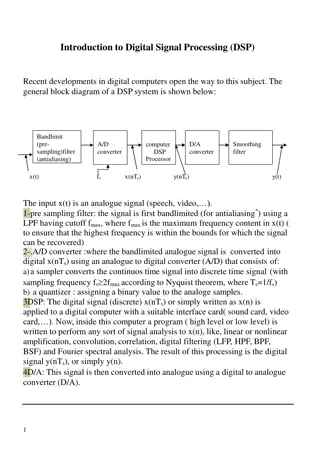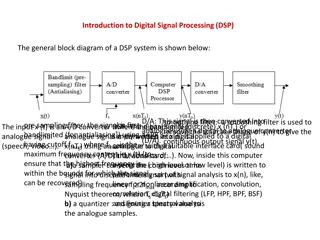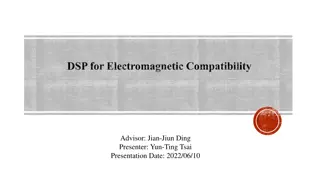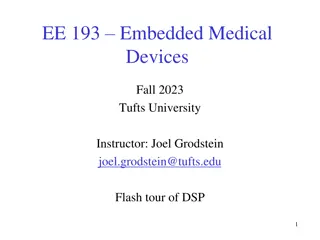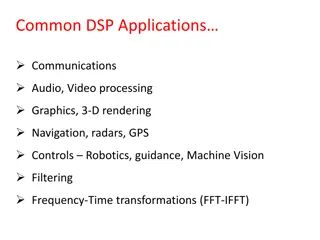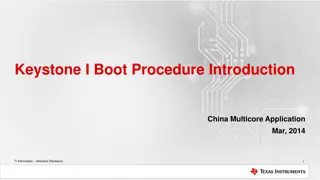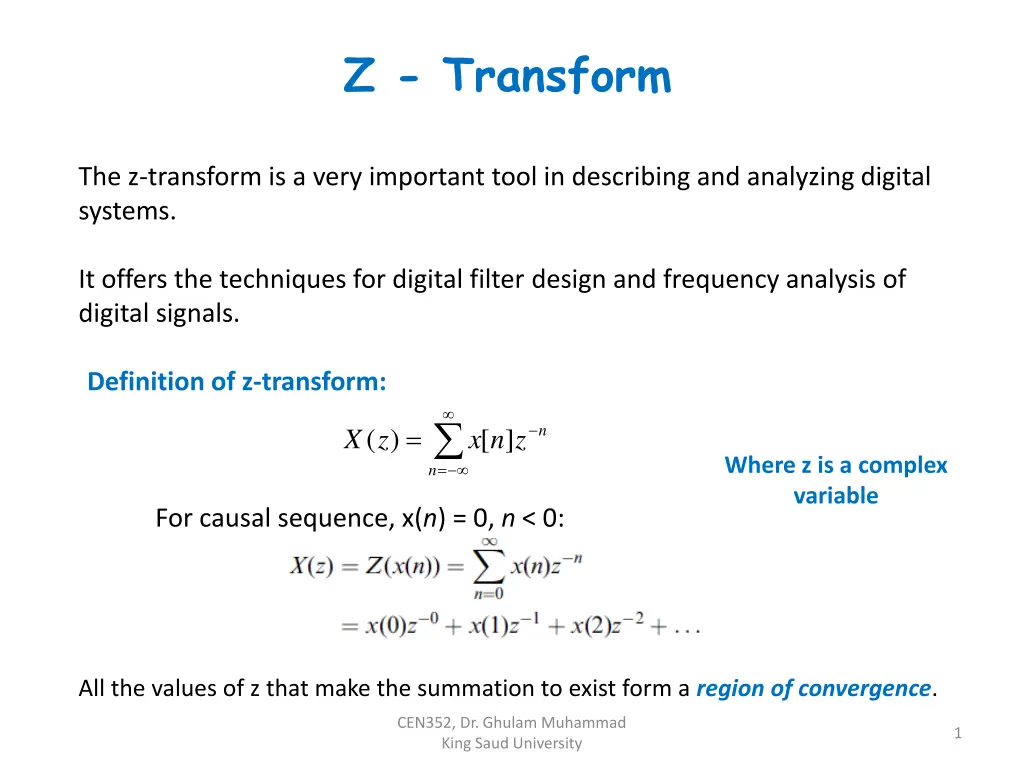
Understanding z-Transform for Digital Systems Analysis
Learn about the z-transform, a crucial tool for digital systems analysis, and how it is applied in digital filter design and signal frequency analysis. Explore examples, properties, and the z-transform table.
Download Presentation

Please find below an Image/Link to download the presentation.
The content on the website is provided AS IS for your information and personal use only. It may not be sold, licensed, or shared on other websites without obtaining consent from the author. If you encounter any issues during the download, it is possible that the publisher has removed the file from their server.
You are allowed to download the files provided on this website for personal or commercial use, subject to the condition that they are used lawfully. All files are the property of their respective owners.
The content on the website is provided AS IS for your information and personal use only. It may not be sold, licensed, or shared on other websites without obtaining consent from the author.
E N D
Presentation Transcript
Z - Transform The z-transform is a very important tool in describing and analyzing digital systems. It offers the techniques for digital filter design and frequency analysis of digital signals. Definition of z-transform: = n = n ( ) [ ] X z x n z Where z is a complex variable For causal sequence, x(n) = 0, n < 0: All the values of z that make the summation to exist form a region of convergence. CEN352, Dr. Ghulam Muhammad King Saud University 1
Example 1 Problem: find the z transform of x(n). Given the sequence, Solution: We know, 1 1 z Therefore, = = = ( ) X z 1 z 1 1 1 z z 1 Region of convergence 1 | | 1 | | 1 z z When, CEN352, Dr. Ghulam Muhammad King Saud University 2
Example 2 Problem: Given the sequence, find the z transform of x(n). Solution: 1 1 z Therefore, = = = ( ) X z a 1 1 az z a 1 Region of convergence z | | 1 | 1 | az z a When, CEN352, Dr. Ghulam Muhammad King Saud University 3
Z-Transform Table CEN352, Dr. Ghulam Muhammad King Saud University 4
Example 3 Problem: Find z-transform of the following sequences. b. a. Solution: From line 9 of the Table: a. From line 14 of the Table: b. CEN352, Dr. Ghulam Muhammad King Saud University 5
Z- Transform Properties (1) Linearity: a and b are arbitrary constants. Example 4 Problem: Find z- transform of Solution: Line 3 Using z- transform table: Line 6 Therefore, we get CEN352, Dr. Ghulam Muhammad King Saud University 6
Z- Transform Properties (2) Shift Theorem: Verification: n = m Since x(n) is assumed to be causal: Then we achieve, CEN352, Dr. Ghulam Muhammad King Saud University 7
Example 5 Problem: Find z- transform of Solution: Using shift theorem, Using z- transform table, line 6: CEN352, Dr. Ghulam Muhammad King Saud University 8
Z- Transform Properties (3) Convolution In time domain, Eq. (1) In z- transform domain, Verification: Using z- transform in Eq. (1) CEN352, Dr. Ghulam Muhammad King Saud University 9
Example 6 Problem: Given the sequences, Find the z-transform of their convolution. Solution: Applying z-transform on the two sequences, From the table, line 2 Therefore we get, CEN352, Dr. Ghulam Muhammad King Saud University 10
Inverse z- Transform: Examples Find inverse z-transform of Example 7 We get, Using table, Example 8 Find inverse z-transform of We get, Using table, CEN352, Dr. Ghulam Muhammad King Saud University 11
Inverse z- Transform: Examples Find inverse z-transform of Example 9 Since, By coefficient matching, Therefore, Example 10 Find inverse z-transform of CEN352, Dr. Ghulam Muhammad King Saud University 12
Inverse z-Transform: Using Partial Fraction Problem: Example 11 Find inverse z-transform of Solution: First eliminate the negative power of z. Dividing both sides by z: Finding the constants: Therefore, inverse z-transform is: CEN352, Dr. Ghulam Muhammad King Saud University 13
Inverse z-Transform: Using Partial Fraction Problem: Example 12 Solution: Dividing both sides by z: We first find B: Next find A: CEN352, Dr. Ghulam Muhammad King Saud University 14
Example 12 contd. Using polar form Now we have: Therefore, the inverse z-transform is: CEN352, Dr. Ghulam Muhammad King Saud University 15
Inverse z-Transform: Using Partial Fraction Problem: Example 13 Solution: Dividing both sides by z: m = 2, p = 0.5 CEN352, Dr. Ghulam Muhammad King Saud University 16
Example 13 contd. From Table: Finally we get, CEN352, Dr. Ghulam Muhammad King Saud University 17
Partial Function Expansion Using MATLAB Problem: Example 14 Solution: The denominator polynomial can be found using MATLAB: Therefore, The solution is: CEN352, Dr. Ghulam Muhammad King Saud University 18
Partial Function Expansion Using MATLAB Problem: Example 15 Solution: CEN352, Dr. Ghulam Muhammad King Saud University 19
Partial Function Expansion Using MATLAB Problem: Example 16 Solution: CEN352, Dr. Ghulam Muhammad King Saud University 20
Difference Equation Using Z-Transform The procedure to solve difference equation using z-transform: 1. Apply z-transform to the difference equation. 2. Substitute the initial conditions. 3. Solve for the difference equation in z-transform domain. 4. Find the solution in time domain by applying the inverse z-transform. CEN352, Dr. Ghulam Muhammad King Saud University 21
Example 17 Problem: Solve the difference equation when the initial condition is Solution: Taking z-transform on both sides: Substituting the initial condition and z-transform on right hand side using Table: Arranging Y(z) on left hand side: CEN352, Dr. Ghulam Muhammad King Saud University 22
Example 17 contd. Solving for A and B: Therefore, Taking inverse z-transform, we get the solution: CEN352, Dr. Ghulam Muhammad King Saud University 23
Example 18 Problem: A DSP system is described by the following differential equation with zero initial condition: a. Determine the impulse response y(n) due to the impulse sequence x(n) = (n). b. Determine system response y(n) due to the unit step function excitation, where u(n) = 1 for n 0. Solution: Taking z-transform on both sides: a. Applying on right side CEN352, Dr. Ghulam Muhammad King Saud University 24
Example 18 contd. We multiply the numerator and denominator by z2 Solving for A and B: Therefore, Hnece the impulse response: CEN352, Dr. Ghulam Muhammad King Saud University 25
Example 18 contd. b. The input is step unit function: Corresponding z-transform: [Slide 24] Do the middle steps by yourself! CEN352, Dr. Ghulam Muhammad King Saud University 26







